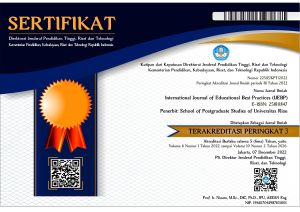WHATSAPP AS A LEARNING TOOL DURING COVID -19 PANDEMIC: ADVANTAGES AND DISADVANTAGES
DOI:
https://doi.org/10.31258/ijebp.5.2.168-182Keywords:
WhatsApp, online learning, covid-19 pandemicsAbstract
The purpose of the present study is to explore the advantages and disadvantages of WhatsApp (WA) as a learning tool during Covid19 pandemic. WA is a messaging application that can be installed on smartphones and has many useful features. Researchers are
interested in researching since many students and lecturers choose WA as an application for continuous learning while one knows that
many applications are actually intended for learning. The design of this research is a mix method (quantitative and qualitative). This
research involved 168 respondents as a sample. The instrument of this research was an open-ended questionnaire. To analyze the
questionnaire, the researchers used the data analysis based on Miles, Huberman, & Saldana (2014). Three steps were applied: data
condensation, data display, and drawing and verifying conclusions. The study concludes that 73 percent of respondents believed that
WA has more advantages than disadvantages. The advantages include it is effective and easy to use; the features are helpful, save
internet quota, very light, easy to do communication, easy to observe the students. The disadvantages, however, is easy for the
students to cheat, old chats are easily piled up by the new chats, the upload size is limited, and member capacity in the group is limited.
These findings confirm that WA can be used as a learning tool with few limitations.
References
Abbad, M. M., Morris, D., & de Nahlik, C. (2009). Looking under the Bonnet: Factors Affecting Student Adoption of E-Learning Systems in Jordan. The International Review of Research in Open and Distance Learning.
Adomi, E. (2019). Work related WhatsApp groups as knowledge sharing platforms among librarians in selected federal universities in Nigeria. Journal of ICT Development, Applications and Research., 1, 11–19.
Amal, K. B. (2019). Pembelajaran Blended Learning Melalui WhatsApp Group (WAG). Prosiding Seminar Nasional Fakultas Sosial Universitas Negeri Medan, 3, 700–702.
Bansal, T., & Joshi, D. (2014). A Study of Students’ Experiences of Mobile Learning. Global Journal of Human-Social Science Research, 5(6), 45–56. https://socialscienceresearch.org/index.php/GJHSS/article/view/1326
Basar, A. M. (2021). Problematika Pembelajaran Jarak Jauh Pada Masa Pandemi Covid-19. Edunesia :
Jurnal Ilmiah Pendidikan, 2(1), 208–218. https://doi.org/10.51276/edu.v2i1.112
Burhoumi, C. (2015). The Effectiveness of WhatsApp Mobile Learning Activities Guided by Activity Theory on Students’ Knowledge Management. Contemporary Educational Technology, 6(3), 221–238.
Church, K., & de Oliveira, R. (2013). What’s up with whatsapp?: comparing mobile instant messaging behaviors with traditional SMS. Proceedings of the 15th International Conference on Human-Computer Interaction with Mobile Devices and Services. New York: ACM., 252–361. https://doi.org/https://doi.org/10.1145/2493190.2493225
Cohavi, A. (2013). How did Whatsapp became the strongest social network? Calcalist.
Dhahir, D. F. (2020). The Usability of Whatsapp Messenger as Online Teaching-Learning Media. Journal of Information Technology and Its Utilization, 3(2), 48–52.
Djamdjuri, D. S., & Kamilah, A. (2020). Whatsapp Media in Online Learning during Covid-19 Pandemic. English Journal, 14(2), 69–74.
Gon, S., & Rawekar, A. (2017). Effectivity of E-Learning through Whatsapp as a Teaching Learning Tool. MVP Journal of Medical Sciences, 4(19). https://doi.org/19.10.18311/mvpjms/0/v0/i0/8454.
Gonzalez, D., & Louis, R. St. (2018). Online Learning. J. I. Liontas (Ed.). The TESOL Encyclopedia of
English Language Teaching (1st Ed.). https://doi.org/https://doi.org/10.1002/9781118784235.eelt0423
Gusuringa, N. I. B. (2018). The Contribution of Chat Using Whatsapp on The Student’s Ability in Developing English Writing Sixth Semester of English Department at Uinsu. Thesis. Faculty of Tarbiyah Science and Lecturer Training. Department of English Education. State Islamic University of North Sumatra: Medan.
Hendro, E., & Eko, P. M. (2016). The Effect og Using WhatsApp Messenger on Students Achievement in KKH class at PBIO FKIP UAD. Ahmad Dahlan University.
La Hanisi, A., Risdiany, R., Dwi Utami, Y., & Sulisworo, D. (2018). The Use of WhatsApp in collaborative learning to improve English teaching and learning process. International Journal of Research Studies in Educational Technology, 7(1). https://doi.org/https://doi.org/10.5861/ijrset.2018.3004
Miles, M. B., Huberman, A. M., & Saldana, J. (2014). Qualitative Data Analysis A Methods Sourcebook. Sage: London.
Munir, S., Erlinda, R., & Nursalim, H. A. (2021). Students’ Views on the Use of WhatsApp during Covid-19 Pandemic: A Study at IAIN Batusangkar. Indonesian Journal of English Language Teaching and Applied Linguistics, 5(2), 323–333. https://doi.org/http://dx.doi.org/10.21093/ijeltal.v5i2.740
Nursalim, H. A. (2021). Students’ Opinion on The Use of WhatsApp Application in English Teaching Department Classes during Covid-19 Pandemics. Thesis. Faculty of Tarbiyah and Teaching Training. State Institute of Islamic Studies (IAIN) Batusangkar: Batusangkar.
Plana, M. G., Hopkins, J. E., Plana, M. G., & Appel, C. (2013). Improving learners ’ reading skills through instant short messages : a sample study using WhatsApp Global perspectives on Computer-Assisted Language Learning Improving learners ’ reading skills through instant short messages : a sample study using WhatsAp. IV World CALL Conference, July, 10–13.
Statista.com. (2020). Penetration of Leading Social Networks in Indonesia as of Q3 2020. Retrieved from htttp://www.statista.com>statistics>Indonesia-social-net.
Watson, G., & Sottile, J. (2010). Cheating in the Digital Age: Do Students Cheat More in Online Courses?. Online Journal of Distance Learning Administration, 13(1).





